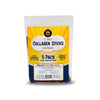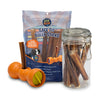If you think that winter means you’ve got a couch potato canine on your hands, then think again! With a little imagination (and a little know-how), you can turn your house into a doggy gym or turn a quick walk around the corner into a cross-fit workout.
We’ve got four fun exercise ideas you may or may not have tried. Either way, there’s no time like the beginning of the year to try something new. As with any exercise recommendations, if you have any concerns, please contact your veterinarian before beginning. The below exercise ideas are meant for dogs in good health, who don’t have physical limitations and have a baseline capacity for exercise.
1. Walk with a Weighted Vest
Weighted vests for dogs are a great way to up the exercise factor of an everyday walk. They fit over the back and around their abdominal region, and have pockets on either side you can fill to weigh them down. Make sure to buy the appropriate size—pockets should never be able to “slap” against the body and should be secured properly.
- Add bags of sand or water to the pockets. Evenly distributed across both sides of the body in the appropriate vest pockets.
- Start with lower amounts of weight and slowly increase the amount that your dog is asked to carry. It’s important to never exceed 10% of your dog’s body weight (if you’re unsure about their weight, get them weighed first!).
- Be sure to decrease the length of the walks/hikes on colder days or as your dog builds stamina. Keeping the distance shorter avoids overexerting your dog.
2. Try Joring!

Joring is a fun way to incorporate our dog’s innate drive to work and pull with exercise! This sport begins with an appropriate harness that the dog wears and allows him to pull his human on a sled, skis, or even a scooter or a skateboard! It does take practice, but it is loads of fun.
- Do some online research to see if joring is a good activity for you and your dog.
- There are different types of harnesses for different kinds of activities. Make sure you make a decision about what type of activity you want to try before you purchase a harness.
3. Find a local indoor agility course or class

There’s nothing more exciting than seeing your dog engage their brain while also engaging their body! Luckily, many cities and towns have agility courses and classes you can sign up for. Watch them as they weave, jump, and balance their way through a course. With an agility course under their belt, you can forget about needing additional exercise for the day. But be forewarned—this is so fun and addicting that you may find it as a year-round source of exercise and bonding between you and your pet.
4. When in doubt, stay indoors and walk on a treadmill!

If you haven’t walked your dog on a treadmill, you’re in for a treat. Most dogs take very easily to walking on a treadmill and with a little bit of help via some treats and patience, you could have a go-to indoor option all winter long.
- Be sure to keep their walking pace to a realistic one. Too fast could cause injury or make them afraid.
- Remember that most dogs stop and sniff when walking outside—so a straight non-stop walk on a treadmill should last shorter than the usual walk outside.

















